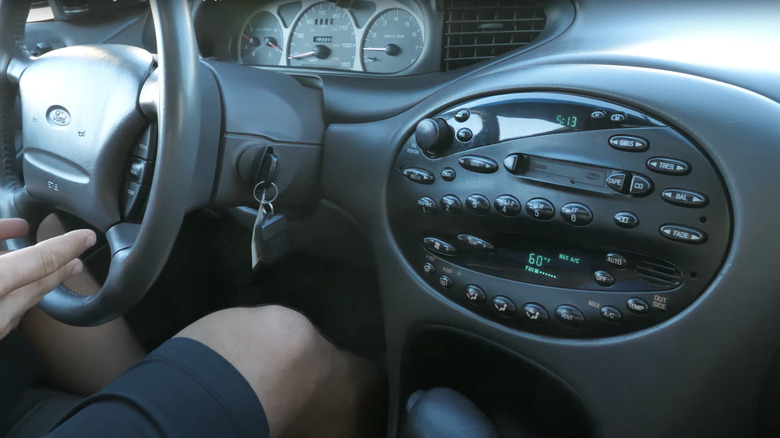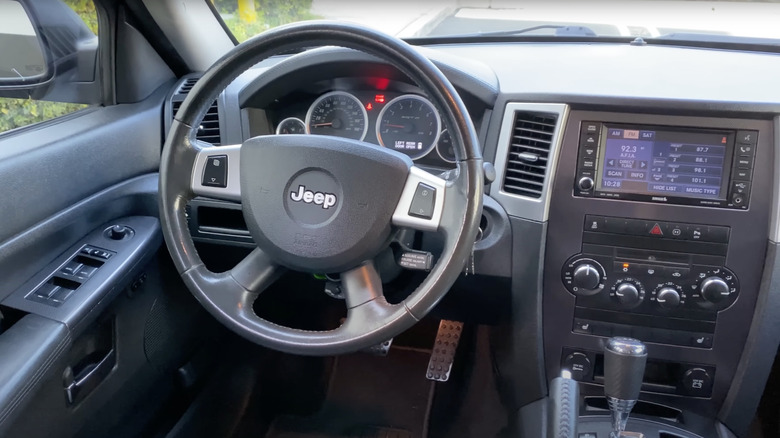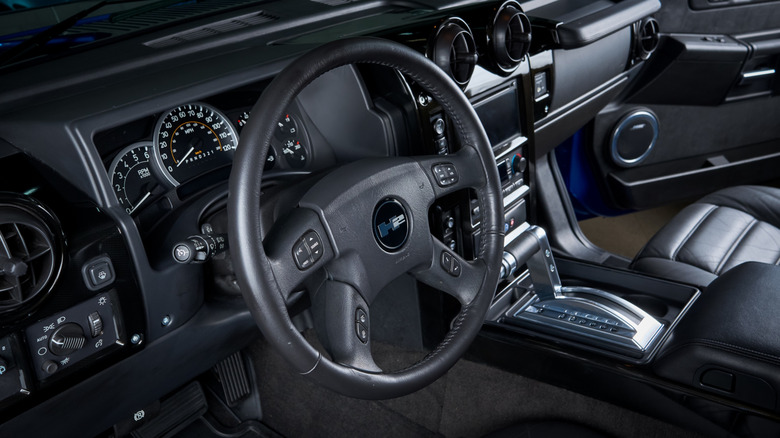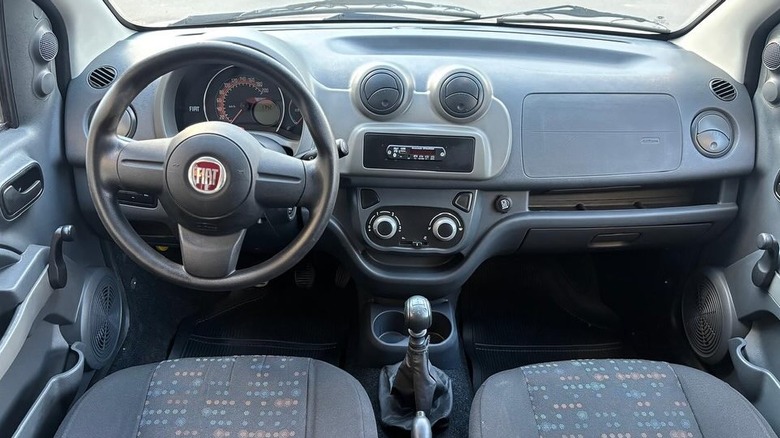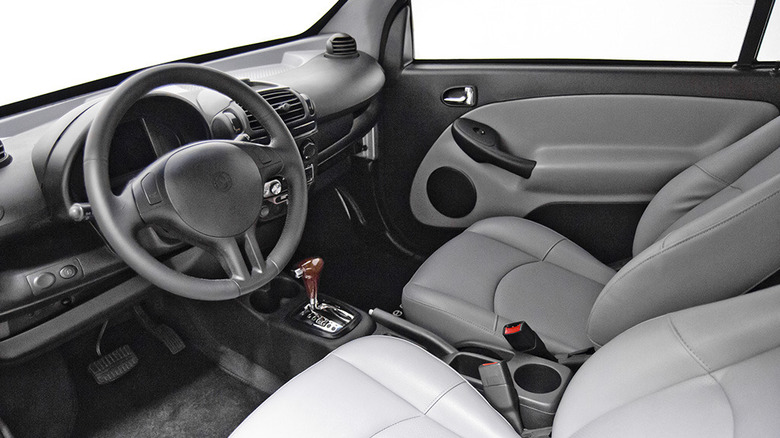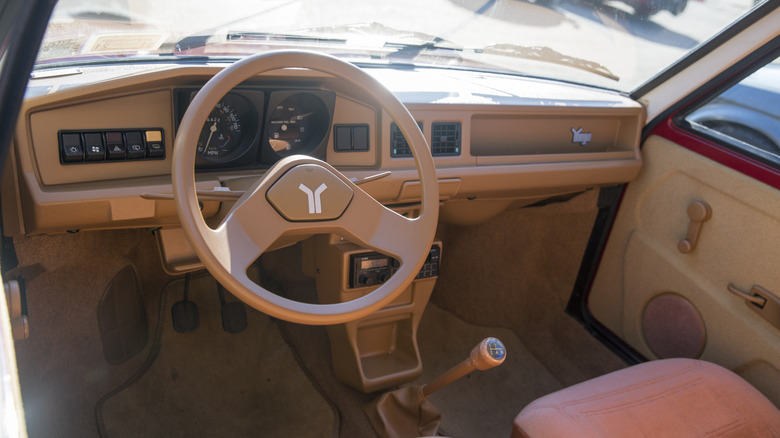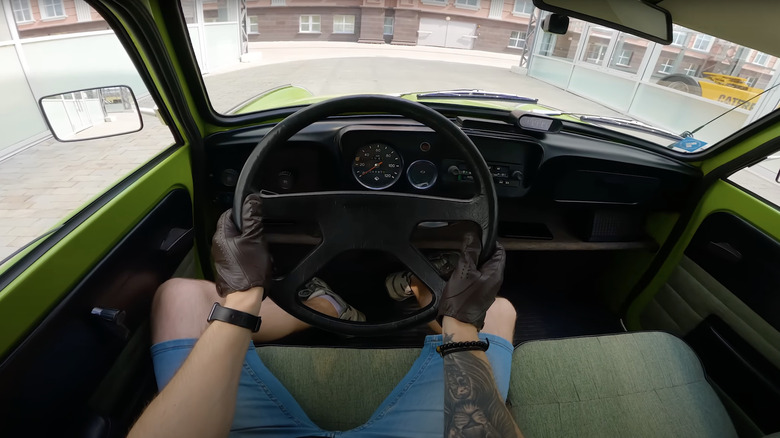8 Of The Worst-Looking Interiors In Automotive History
What's the most important thing you might look for when buying a new car? Reliability, horsepower, or maybe the exterior design? Maybe it speaks to your heart most of all? While these are all pretty important qualities, there's one aspect that doesn't really seem to get talked about quite as much, and that is the vehicle's interior.
Sure, the interior has to be good from a functional standpoint, but it's also rather important that it looks nice. You won't exactly pet your dashboard or door panels while driving, but a well-designed interior with attention to detail is nice to have.
Some automakers pay more attention to the interior than others, but for some, the interior is just a complete afterthought. Usually, a poor interior comes down to quality, but a lot of times, it can be a bit of an ergonomic nightmare as well. Overall, these interiors are pretty depressing places to be.
Ford Taurus (Third Generation)
One of the most fascinating cars in American car history, Ford discontinued the Taurus after over 30 years in 2019. Of all the generations of Taurus, the third generation, available throughout the late 90s and early 2000s, is the most controversial.
That's due to two main reasons: the strange rounded exterior design and the puzzling decision to continue the rounded design motif on the inside. The main theme of this Taurus was clearly rounded shapes, which is why Ford's interior designers thought it would be a good idea to house most of the interior controls in an oval-shaped panel in the center.
I'm not exactly sure who signed off on this, but it's weird. It's a bit like those old Nokia phones that tried their best to reinvent the traditional phone keypad layout and failed miserably. Everything from the stereo to the climate controls is mashed together in one giant oval, and it doesn't look good. As you might imagine, being a late '90s Ford product, the quality of the materials wasn't much up to snuff, either.
Jeep Grand Cherokee (WK)
Introduced at the 2004 New York Auto Show, the WK Grand Cherokee was the first generation to offer the SRT8 model, which is a pretty cool SUV in and of itself. The regular Grand Cherokee was a bit of a different story, though. It did have some good qualities, but it faced a lot of criticism about the interior. One look at it is enough to see why.
Despite billing itself as a luxury SUV, the interior of the WK Grand Cherokee is anything but opulent. Somebody told Jeep that a navigation system and power seats and pedals were enough to be considered luxurious. Nobody told the interior designers that horribly cheap plastic and hideous fake wood trim don't exactly help its case. As well as being cheap and plasticky on the inside, some of the WK Grand Cherokees have common problems, and they're worth keeping an eye on.
To add insult to injury, there's lots of unused space, and you simply get the sense that the designers weren't exactly trying hard enough. It's a very different story now, but back in the day of the WK Grand Cherokee, Jeep still hadn't figured out the whole luxury thing. Being a Jeep, it's not exactly going to age well, either, from a functional standpoint.
Hummer H2
If you grew up in the early 2000s, your memories of the Hummer H2 are either thanks to rap music videos, various celebrities like LeBron James buying them and modifying them to silly degrees, or because it was one of the three luxury SUVs in 2004's Need for Speed Underground 2.
After General Motors took over AM General, it created the Hummer H2 as a tribute to the original war machine to street machine conversion, the Humvee and Hummer H1. It was a more luxurious, down-to-earth SUV offering that would hearken back to the military legend we all know and love. While we appreciate the effort, this isn't it.
Doug DeMuro explained (and mocked) it all very well in his YouTube video. In addition to all the exterior styling details being fake decorations, the interior is an absolute hodgepodge. There is unused space, horrible trim that was still up to the GM standard of the time, and an overall lack of quality. That wasn't the end of the interior woes in the H2, as the driver also had to contend with completely useless outward visibility in the name of style.
Fiat Uno Vivace
Before the Fiat Punto took the European market by storm, Fiat's main rival to the VW Golf was the Uno. It was a boxy hatchback that was pretty simple, although there was a cool Turbo model on offer as well. Long after the Uno was discontinued in Europe, the nameplate lived on in some of Fiat's most lucrative markets, namely Brazil and Latin America.
In 2010, Fiat Brazil revived the Uno as an entry-level hatchback model to compete with Latin America's other favorite small car, the VW Gol — yes, without the F. Like the Gol, the Uno was designed from the get-go to be a very basic car, and that's immediately obvious when you look at the interior.
The basic Fiat Uno Vivace was properly depressing on the inside. The entire dashboard was black hard plastic, there was a blank plate on the radio panel, and you had all of two dials and one lever for the climate controls. I genuinely feel sorry for any person from Latin America who had to put up with this interior. The more upscale trim levels did improve things a little bit, but you have to wonder, how far can the cost-cutting be taken before it's significantly detrimental to the experience behind the wheel?
Wheego LiFe
The early 2010s saw a lot of startup automakers in the U.S. come and go, each one with their own idea of an everyday usable high-speed electric vehicle. One such automaker was Wheego, and it had an idea that sounded good on paper. Wheego bought out body shells from China's infamous Smart Fortwo copycat, the Shuanghuan Noble, and then shoehorned in-house engineered electric drivetrains to create the low-speed Whip and then the highway capable LiFe.
The Chinese auto industry has come a long way since then, with some really cool cars coming out of China nowadays. But back when the LiFe was on sale, it was a totally different story. That's to say, quality control and building things to last were foreign concepts to Shuanghuan. Robert Dunn of Aging Wheels put it very well in his review of his own LiFe.
The interior was made to look like the Smart Fortwo's interior, but the engineering ... actually, I'm not sure if there was that much engineering involved. It would be easier if I summarized it, so here goes: The Wheego LiFe's interior would eventually start falling to pieces, with all kinds of components outright failing or disintegrating. This is a good time to mention that back in the early 2010s, the LiFe retailed for around $33,000.
Yugo
There's no way to talk about the worst automotive interiors without mentioning the Yugo, widely regarded as one of the worst cars ever. Built in the former Yugoslavia, the Yugo was one of many cars that were a product of socialism. It was merely a mode of transportation, and it was intended to be a very basic car right from the onset, in the name of being affordable for many Yugoslav people.
The Yugo shares a lot of its components with several Fiat vehicles, but Yugoslav automaker Zastava molded to fit the taste of the local demographic. Due to the company's less-than-ideal standards and the Yugo's cheap-car-from-day-one philosophy, the interior wasn't exactly what you might call nice.
There was hardly anything in the way of features. Most Yugos left the factory without a tachometer, despite most of them having manual transmissions. Air conditioning? Forget it. There are only two climate vents and barely any climate controls at all. The company also used the cheapest possible plastic and construction techniques, which made the Yugo an overall depressing place to spend time. It didn't help matters that the interior had a tendency to fall apart.
Trabant
Most Americans probably think that there couldn't have been a car developed under socialism and communism that was worse than the Yugo, right? Boy, are they wrong. While Yugoslavia had the Yugo and other built-under-license Fiats to contend with, East Germany had the Trabant. It was a little '50s-inspired two-door sedan with bodywork made from recycled cotton and a two-stroke engine that produced a smoke trail longer than the car itself.
Robert Dunn of Aging Wheels on YouTube has owned a Trabant for years now, and as he often tells us, owning a Trabant is quite the experience. In addition to putting up with the car's terrible build quality and sporadic two-stroke motor, you also have to deal with the interior.
Have you ever seen an interior with such an unapologetic lack of features? A couple of knobs, a couple of buttons, a speedometer and a shifter on the column. Oh, and a steering wheel, of course. Most Trabants don't even have a fuel gauge on the inside. You have to measure the fuel and oil mixture with a dipstick. Because that's fun, right?
Lada Oka
Now we have to complete the holy trinity of communist cars. Lada, much like Zastava, also built a whole bunch of terrible cars that started their lives out as Fiats. You're likely familiar with the Riva and the Niva/4x4, but Lada also had an entry-level model for a long time.
Yes, really, this automaker known for making nothing more than the most basic of cars had an entry-level model. That's like creating a more basic form of white bread. Enter the Lada Oka, otherwise known as the VAZ-1111, a tiny little car that was the entry point into the Lada lineup from the late '80s all the way to the late 2000s. Because, you know, that's how Lada does things.
Most Okas were powered by tiny two-cylinder engines that drove the wheels through a four-speed manual transmission. In order to drive it, you had to sit in this utterly depressing interior. We can't sugarcoat it, it's really that bad. It's an endless sea of black plastic, two climate control vents that point upwards despite being meant for the driver and passenger, a couple of switches, and a speedometer. If you want creature comforts, you're asking too much.
The most interesting thing about the Lada Oka is that you don't actually have to go through the trouble of importing one yourself. If, for some bizarre reason, you want some Oka action in your life, you can actually buy a neighborhood EV converted Oka directly from an American company.

